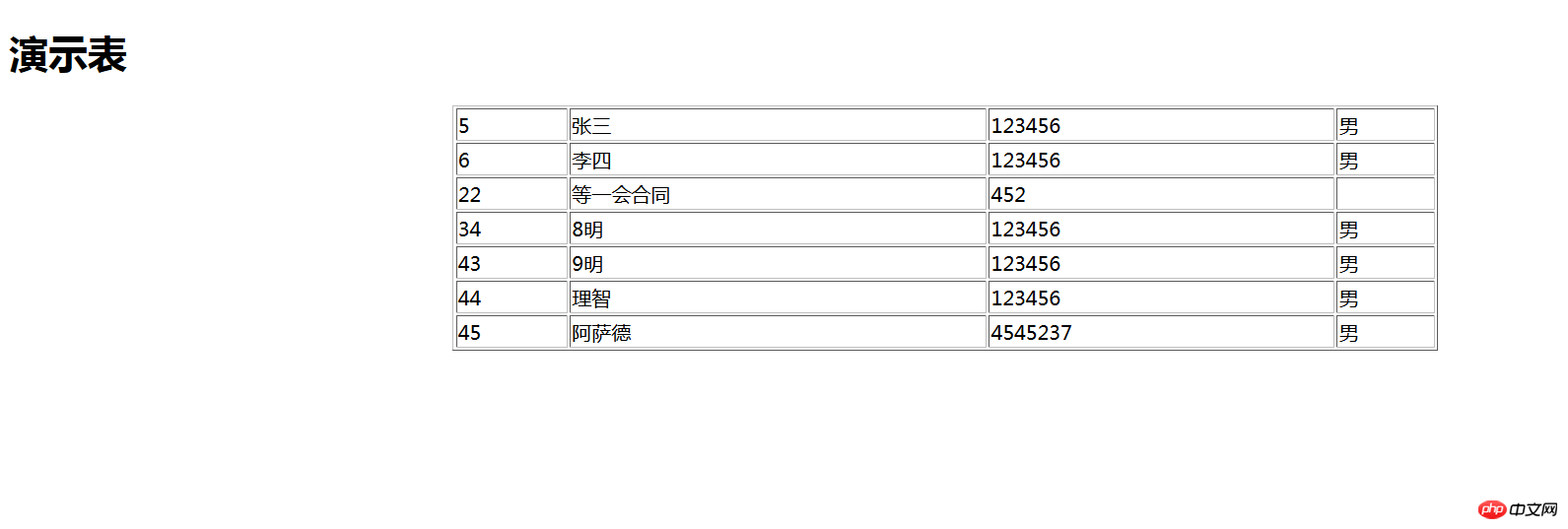Home > Article > Backend Development > PHP method to obtain database result set
This article mainly introduces the method of obtaining the database result set in PHP. Interested friends can refer to it. I hope it will be helpful to everyone.
PHP often needs to access the database to advance the data in the database, so how to advance the data?
The code to extract the database is as follows:
';//获取的数据用表格显示出来 echo ''; while($arr=mysql_fetch_assoc($res)){//取出表study_sql中的所有结果集 echo ' 演示表
'; foreach($arr as $col){//遍历数据 echo ' "; } ?>'.$col.' '; } echo "

Commonly used SQL functions are as follows:
mysql_affected_rows — Get the number of record rows affected by the previous MySQL operation
mysql_cpent_encoding — Return the name of the character set
mysql_close — Close the MySQL connection
mysql_connect — Open a connection to the MySQL server
mysql_create_db — Create a new MySQL database
mysql_data_seek — Move internal results Pointer
mysql_db_name — Get result data
mysql_db_query — Send a MySQL query
mysql_drop_db — Drop (delete) a MySQL database
mysql_errno — Return to the previous one Numeric encoding of error messages in MySQL operations
mysql_error — Returns the text error message generated by the previous MySQL operation
mysql_escape_string — Escapes a string for use with mysql_query
mysql_fetch_array — Get a row from the result set as an associative array, or a numeric array, or both
mysql_fetch_assoc — Get a row from the result set as an associative array
mysql_fetch_field — Get the column information from the result set and Returned as an object
mysql_fetch_lengths — Get the length of each output in the result set
mysql_fetch_object — Get a row from the result set as an object
mysql_fetch_row — Get a row from the result set as an enumeration Array
mysql_field_flags — Get the flags associated with the specified field from the result
mysql_field_len — Return the length of the specified field
mysql_field_name — Get the field name of the specified field in the result
mysql_field_seek — Set the pointer in the result set to the specified field offset
mysql_field_table — Get the table name where the specified field is located
mysql_field_type — Get the type of the specified field in the result set
mysql_free_result — Release result memory
mysql_get_cpent_info — Get MySQL client information
mysql_get_host_info — Get MySQL host information
mysql_get_proto_info — Get MySQL protocol information
mysql_get_server_info — Get MySQL server information
mysql_info — Get the latest query information
mysql_insert_id — Get the ID generated by the previous INSERT operation
mysql_pst_dbs — List All databases in the MySQL server
mysql_pst_fields — List the fields in the MySQL results
mysql_pst_processes — List the MySQL processes
mysql_pst_tables — List the tables in the MySQL database
mysql_num_fields — Get the number of fields in the result set
mysql_num_rows — Get the number of rows in the result set
mysql_pconnect — Open a persistent connection to the MySQL server
mysql_ping — Ping a server connection, or reconnect if there is no connection
mysql_query — Send a MySQL query
mysql_real_escape_string — Escape special characters in a string used in an SQL statement, taking into account the connection Current character set
mysql_result — Get result data
mysql_select_db — Select MySQL database
mysql_set_charset — Set the client’s character set
mysql_stat — Get the current system status
mysql_tablename — Gets the table name
mysql_thread_id — Returns the ID of the current thread
mysql_unbuffered_query — Sends a SQL query to MySQL without retrieving and caching the result rows
Related recommendations:
How PHP operates MySQLdatabase based on ORM
PHP encapsulated PDODatabase Operation class instance analysis
PHP Detailed explanation of the method of exporting from database to a .csv file
The above is the detailed content of PHP method to obtain database result set. For more information, please follow other related articles on the PHP Chinese website!